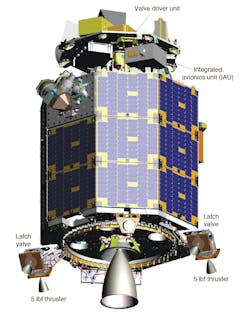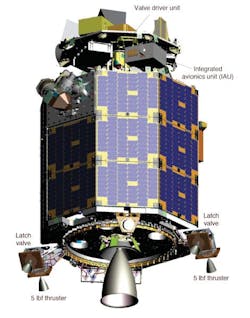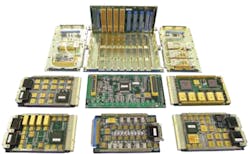Recently, NASA cleared its Lunar Atmosphere Dust and Environment Explorer (LADEE) craft for a 28-day mission extension so it can gather more information about the moon’s atmosphere. “The launch-vehicle performance and orbit-capture burns using LADEE’s onboard engines were extremely accurate, so the spacecraft had significant propellant remaining to conduct more research,” says Butler Hine, LADEE project manager at NASA’s Ames Research Center, Moffett Field, Calif.
Part of LADEE’s life-extending components include an avionics controller that gathers data from a star tracker, an inertial-measurement unit, and sun sensors to drive the spacecraft into orbit positions through connections with power circuitry controlling the craft’s thruster valves. The 13.8-lb integrated avionics unit (IAU) is 9.90 x 8.26 x 4.68 in. It’s sturdy enough to withstand the extreme temperatures and radiation of space partly because engineers of Moog Inc., Huntsville, Ala., and Moog Broad Reach Engineering, Tempe, Ariz., designed its electronics with silicon coatings to resist ionization and eliminate the need for protective shields or metal enclosures.
Moog engineers designed LADEE’s four bipropellant 5-lbf thrusters 12 years ago. Each thruster has an injector and platinum-alloy combustion chamber to mix the hypergolic propellants (which ignite on contact, without an electric or thermal igniter). The combustion chamber resists oxidation and withstands temperatures exceeding 2,600°F. The injector design controls the fuel and oxidizer propellant impingement angles and velocities for a perfect mix.
The thrusters first flew on a microsatellte-tehnology experiment mission in 2006, and their first commercial flight was in 2009 on the launch of the Telstar-11N communication satellite. In fact, an array of commercial and civil craft for telecommunications and space exploration now uses more than 200 of the thrusters.
Two flow-control valves for LADEE meter propellants into the injectors. The torque-motor-actuated valves stay magnetically latched open (to allow flow of propellant to the thrusters) or closed (for a leakproof storage of the propellants). An electrical signal prompts valve actuation through a microswitch. The valves control the flow of both oxidizer and fuel to the thrusters with a single actuator, which reduces the component count and overall mass and cost.
LADEE’s 5.5-kg valve-driver unit, a stand-alone switch-extension platform from Moog measuring 5.6 x 7.9 x 3.5 in., controls and monitors the valves. The unit serially communicates commands and status updates with the IAU.
Moog also made LADEE’s Spacecraft Energization and Power Interfacing (SEPIA) unit, a 1.5-lb safety power circuit that isolates the battery and solar-array power from LADEE until the spacecraft separates from the launch vehicle. It has extra connectors that let engineers power the spacecraft through umbilical cables during ground testing.
A flight-control computer in the IAU, a RAD750 from BAE Systems Inc., Arlington, Va., runs the algorithms that control the spacecraft and manage two streams of data communications. The first is data to and from ground stations. The second is with subsystems on LADEE itself, including those for operating the spacecraft as well as four instrument sets, including a lunar-dust experiment, a UV/visible spectrometer, a neutral-mass spectrometer, and a lunar-laser communication demonstration.
The car-sized LADEE has been orbiting the moon since last October at an altitude of 8 to 37 miles to record cyclical changes in the moon’s tenuous atmosphere. It was scheduled to crash into the moon on or around April 21.
More about the LADEE design:
About the Author
Elisabeth Eitel
Elisabeth Eitel was a Senior Editor at Machine Design magazine until 2014. She has a B.S. in Mechanical Engineering from Fenn College at Cleveland State University.


